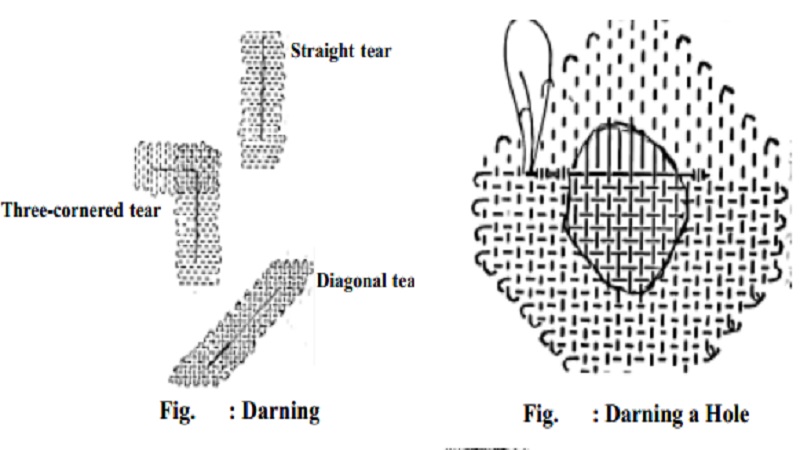Chapter: 11th 12th std standard Home Science Maintain Basic Knowledge for family life Higher secondary school College
Types of Tear

Types of Tear
There are three types of tear, straight tear, three-cornered tear and
diagonal tear.
1. Straight Tear
If a straight tear occurs on a part of the garment that has to with
stand strain, it may be reinforced by a strip of material basted on the wrong
side and held in place by the darning stitches. This material may be the same
as the garment, or it may be similar in colour but lighter in weight.
In case the threads of a garment have worn thin, but have not broken,
they may be reinforced by placing a piece of the same material under the thin
spot and then darning as for a straight tear. The stitches should be taken
through both thicknesses of the material.
2. Three-Cornered Tear
This tear is darned as a straight tear, with the stitches running at
right angles to the opening. The snag is across both lengthwise and crosswise
threads. Begin at one end and darn one side of the tear completely. Then begin
at the other end and darn the other side. This causes the stitches to overlap
at the corner, thus strengthening it.
3. Diagonal Tear
In a diagonal tear both the warp and filling threads are cut. This makes
it necessary to run darning stitches parallel to both sets of threads to mend
the tear securely. The first groups of stitches are made as they are for the
other darns previously discussed, except they are not made at right angles to
the tear. The second group is worked in at right angles to the first.
4.Darning a Hole
To darn a hole insert a darner in the stocking, placing it under the
hole. If the stockings are of cotton, they can be mended with darning cotton of
the same colour, if it is silk silk or mercerized cotton thread should be used.
No knot is used in the thread. Trim a row of small running stitches to the top
of the hole, draw the thread across the opening, and extend the running
stitches below the hole. Continue this until the hole has been covered. Care
should be taken to have the rows of stitches irregular in length to distribute
the strain. Running stitches are then made at right angles to the first ones.
They are crossed over one thread and under one as in a plain weave. When the
darn is finished, the thread is cut without being fastened.
Darning and patching are most commonly used types of mending. There are several types of darns that may be used in repairing fabrics. The kind depends on the position of the tear and the fabric used. Possibly the simplest type is that used in mending a straight tear.
Fundamental rule for Darning
1. The needle should be fine and the thread of the same colour and texture as the material should be used.
2. Fit the edges of the tear together and to reinforce it, begin the stitches about ½ inch beyond its end. Sew back and forth with small running stitches.
3. Do not use a knot in the end of the thread as there is no strain at this point.
4. Continue sewing with small running stitches across the opening to hold the edges to tear together. The rows of stitches should run at right angles to the tear and parallel with the thread of the materials.
5. Have the stitches over the opening alternate, one over and the next one under the edge. This makes a flat darn.
6. The strain will be more evenly distributed if the row of running stitches are irregular in length.
7. Be careful not to draw the stitches tightly enough to cause the darn to pucker.
8. This type of darn is usually made from the right side of the fabric.
Related Topics